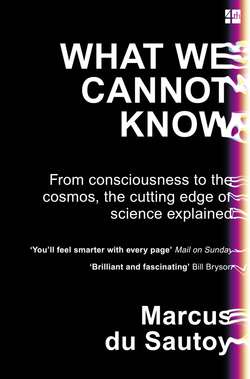Читать книгу What We Cannot Know: Explorations at the Edge of Knowledge - Marcus Sautoy du - Страница 50
PULLING APART THE ATOM
ОглавлениеThe way science works is that you can hang on to your model of the universe until something pops up that doesn’t fit: something new that you can’t seem to explain with the current model. The realization that the atom might be made up of smaller bits emerged out of experiments that revealed something particle-like but much tinier than the atoms that made up the periodic table.
This tiny particle-like object materialized from the British physicist J. J. Thomson’s experiments at the end of the nineteenth century to understand electricity. He had been investigating how electricity was conducted through a gas. Early experiments took a glass tube with two electrodes at either end, and by applying a high voltage between the electrodes an electric current was produced. The strange thing was that he seemed to be able to actually see the current because an arc of light appeared between the two electrodes.
Things became even stranger when he removed the gas completely from the tube and applied the voltage across a vacuum. The arc of light disappeared. But, bizarrely, the glass at the end of one tube was found to fluoresce. Stick a metal cross in the tube and a cross-shaped shadow appeared in the middle of the glowing fluorescent patch.
Electrons emitted from the cathode that hit the opposite wall cause the glass to fluoresce.
The shadow always appeared opposite the negative electrode, otherwise known as the cathode. The best explanation was that the cathode was emitting some sort of ray that interacted with matter and made it glow – either the gas in the tube or, in the case of the vacuum, the glass of the tube itself.
These ‘cathode rays’ were something of a mystery. They were found to pass right through thin sheets of gold when they were placed in the way. Were they some sort of wave-like phenomenon like light? Others thought they were made up of negatively charged particles spat out by the negative electrode and then attracted to the positive electrode. But how could these particles pass through solid gold?
If they were negatively charged particles, then, Thomson believed, he should be able to change their path through the tube by applying a magnetic field. The German physicist Heinrich Hertz had already tried this and failed, but Hertz hadn’t removed enough gas, which interfered with the experiment. With the gas removed, things worked just as Thomson had hoped. Apply a magnetic field to the rays and sure enough the shadow shifted. The rays were being bent by the magnet.
The real surprise came when Thomson made a mathematical calculation of what the mass of these charged particles must be. If you apply a force to a mass then, as Newton’s laws of motion state, the amount you’ll be able to move it will depend on the mass. So the amount of deflection that a magnetic field will cause will have encoded in it information about the mass of this proposed particle.
The calculation also depends on the charge on the particle, and once this was determined in a separate experiment Thomson could work out the mass. The answer was startling. It was nearly 2000 times smaller than the mass of a hydrogen atom, the smallest atom in the periodic table.
That these particles seemed to originate from the metal making up the electrode led to the hunch that these particles were actually smaller constituents of the atom. The atom wasn’t indivisible after all. There were smaller bits. They were called electrons, the name originating from the Greek word for amber, the first substance to exhibit a charge.
The discovery that atoms are made up of even smaller constituents was a shock to many scientists’ view of the world. After Thomson gave a lecture on his findings:
I was told long afterwards by a distinguished physicist who had been present at my lecture that he thought I had been pulling their leg.
